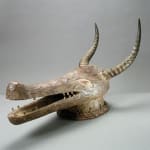Ekoi Zoomorphic Crest Mask, 20th Century CE
Wood, Skin, Horns
10 x 14.5 x 26.375
X.1004
Further images
The Cross River region of southeastern Nigeria spreading into Cameroon abounds in cultures that, though diverse, are unified by certain shared traditions that give rise to the creation of similar...
The Cross River region of southeastern Nigeria spreading into Cameroon abounds in cultures that, though diverse, are unified by certain shared traditions that give rise to the creation of similar objects. The most important of these objects are the crest masks covered with animal hide. Apparently of Ekoi (also called “Ejagham”) origin, these mask have been borrowed by many neighboring tribes, including the Igbo and Ibibio to the west, the Boki to the north, and the Keaka, Annang, and Widekum to the east. Skin-covered headdress were used for a number of purposes in certain secret societies. Among the Boki, three distinct societies have been recorded: the warriors’ society, the hunters’ society, and the women’s society. Masquerade performances generally took place at the initiation or funerals of members of the association that owned them , and also at periodic rites connected with agriculture.
The techniques used in the production of skin-covered masks are more complex than those of most other African mask. The subtractive process of carving is followed by an additive one involving not only the attachment of the skin to the wooden surface, but also inserts of metal or can to represent teeth and eyes. Although there are authenticated cases of human skin being used to cover such masks, the use of painstakingly de-haired and softened antelope skin is much more frequent. The bottom of the masks are typically attached to a wickerwork base designed to fit over the head of a normal-sized human. A textile costume, reaching down to the ankles, was fitted to the underside of the wickerwork base in order to cover the masquerader’s head and face and conceal his identity. Through such ceremonial dances, the tribe sought to communicate and mollify the natural forces that preside over human destinies.
This imposing crest mask attributed to the Ekoi tribe depicts the head of a zoomorphic creature with the elongated mouth of a crocodile and the horns of an antelope. In this case, the horns are indeed actual animal horns that have been secured to the back of the mask. The whole of the head (not including the protruding horns) has been covered in stretched animal hide, perhaps even the hide of the same antelope that provided the horns for this mask. Thin metal strips have been inserted into the top and bottom halves of partially ajar mouth to serve as teeth, further enhancing the intimidating nature of this mask. Such a mask would have been kept by a secret society, likely the hunters’ association. This mask was likely danced during ritual ceremonies relating to this association. Between performances, it was probably carefully wrapped in bark cloth or matting and stored in the rafters near a continually smoldering hearth.
The techniques used in the production of skin-covered masks are more complex than those of most other African mask. The subtractive process of carving is followed by an additive one involving not only the attachment of the skin to the wooden surface, but also inserts of metal or can to represent teeth and eyes. Although there are authenticated cases of human skin being used to cover such masks, the use of painstakingly de-haired and softened antelope skin is much more frequent. The bottom of the masks are typically attached to a wickerwork base designed to fit over the head of a normal-sized human. A textile costume, reaching down to the ankles, was fitted to the underside of the wickerwork base in order to cover the masquerader’s head and face and conceal his identity. Through such ceremonial dances, the tribe sought to communicate and mollify the natural forces that preside over human destinies.
This imposing crest mask attributed to the Ekoi tribe depicts the head of a zoomorphic creature with the elongated mouth of a crocodile and the horns of an antelope. In this case, the horns are indeed actual animal horns that have been secured to the back of the mask. The whole of the head (not including the protruding horns) has been covered in stretched animal hide, perhaps even the hide of the same antelope that provided the horns for this mask. Thin metal strips have been inserted into the top and bottom halves of partially ajar mouth to serve as teeth, further enhancing the intimidating nature of this mask. Such a mask would have been kept by a secret society, likely the hunters’ association. This mask was likely danced during ritual ceremonies relating to this association. Between performances, it was probably carefully wrapped in bark cloth or matting and stored in the rafters near a continually smoldering hearth.







